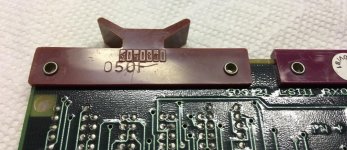I'm happy to report the rx02 emulator has been tested on rxv11 emulating RX01. Works exactly as advertised!
I built a bootable RT11 5.3 image on simh then copied it to the sd card. I couldn't get it to boot... Then I RTFM
image has to be exactly 256256 bytes. After I fixed that It booted right up.
I then:
init dx1:
copy/sys *.* dx1:
Worked great! It's just as slow as I remember RX01 to be ;-)
joe
Good to hear. RX11/RXV11 mode was one that I am unable to test myself (I only have RX02/RX211, RX01/RX8E, and RX02/RX28 configurations).
As to speed, by default the rx02 emulator s/w uses the 'as fast as possible' timing mode selection (t 0) so there are no implicit delays added to any accesses to simulate track seek delay, sector access rotational delay, or data access delay. If you want to see what using a 'real' rx01 would be like, set timing mode to '2' (t 2) to insert these additional delays that simulate accessing a real rx01/rx02 device.
Yes, SIMH does not extend simulated device image files to the full size of the device (it only extends if the blocks are written). So disk images made on SIMH (or even imported from other tools) may not be exactly 256,256 bytes (RX01) or 512,512 bytes (RX02).
My rx02 emulator s/w first used only the file size to detect the image type, and this worked to a point. There are manual intervention menu commands that I implemented to block out files to the RX01 or RX02 image sizes to help mitigate the issue (ie, zero extend or truncate).
More recently I added specific file extensions (.RX1 and .RX2) to flag an image as that type, and not just use image size as the detection parameter.
So a filename with .RX1 extension will be truncated/extended to 256,256 bytes and forced to be RX01 formatted.
A filename with .RX2 extension will be truncated/extended to 512,512 bytes and forced to be RX02 formatted.
Any other filename extension (like .DSK, .IMG, etc) will cause the filesize to be examined, and it must be either 256,256 (exactly) or 512,512 (exactly) bytes to be interpreted as an RX01 or RX02 image, respectively. Other sizes will not be able to be mounted.

